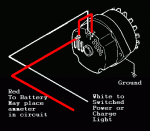Old JD 1020
New member
The Alternator on my John Deere 1020 wore out along with the external regulator. (Replacement Alternator $175, Regulator $57) So I decided to upgrade to a GM 3 wire alternator $50 with internal regulator. Hooked up the new regulator with main hot wire from starter and regulator worked good. (14.5 volts at battery with engine running)
Problem is when I went to hook up the other two leads (post one to alternator light, Post two routed back to hot post on alternator), my alternator light stayed on with the key off and would shut off when I turned the key on?
I disconnected the indicator light & left post two routed back to hot and alternator was working fine. Then I ran a jumper wire from alternator to indicator light to make sure there was no short in the old Ind light wire, same result alt light stayed on with key off. Next I ran a jumper wire from Alternator light to ignition switch to make sure no shorts in that line (jumper from Alternator still connected), same result light stayed on.
I have attached the JD wiring Diagram & the alternator wiring diagram as well.
Any thoughts out there??
Problem is when I went to hook up the other two leads (post one to alternator light, Post two routed back to hot post on alternator), my alternator light stayed on with the key off and would shut off when I turned the key on?
I disconnected the indicator light & left post two routed back to hot and alternator was working fine. Then I ran a jumper wire from alternator to indicator light to make sure there was no short in the old Ind light wire, same result alt light stayed on with key off. Next I ran a jumper wire from Alternator light to ignition switch to make sure no shorts in that line (jumper from Alternator still connected), same result light stayed on.
I have attached the JD wiring Diagram & the alternator wiring diagram as well.
Any thoughts out there??

